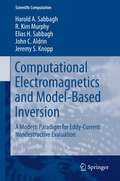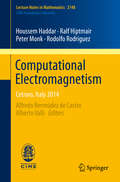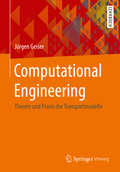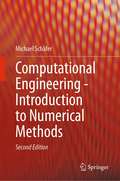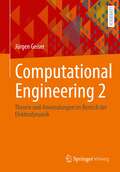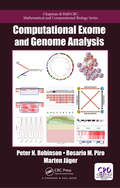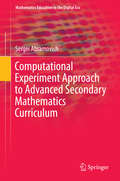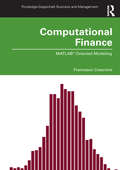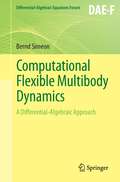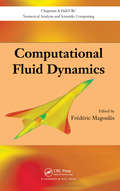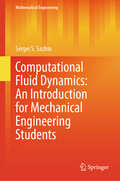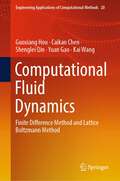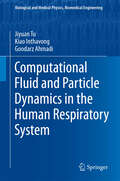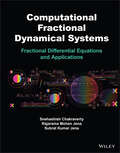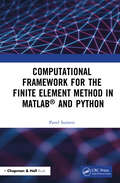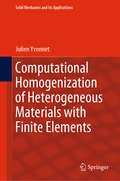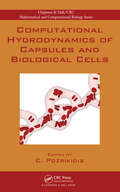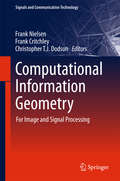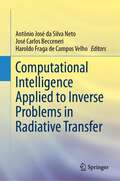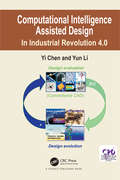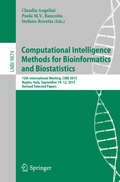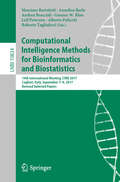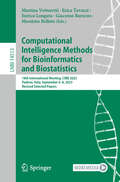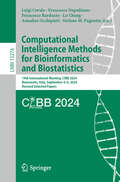- Table View
- List View
Computational Electromagnetics and Model-Based Inversion: A Modern Paradigm for Eddy-Current Nondestructive Evaluation (Scientific Computation)
by Elias H. Sabbagh Harold A Sabbagh Jeremy S Knopp John C. Aldrin R. Kim MurphyThis volume will define the direction of eddy-current technology in nondestructive evaluation (NDE) in the twenty-first century. It describes the natural marriage of the computer to eddy-current NDE, and its publication was encouraged by favorable responses from workers in the nuclear-power and aerospace industries. It will be used by advanced students and practitioners in the fields of computational electromagnetics, electromagnetic inverse-scattering theory, nondestructive evaluation, materials evaluation and biomedical imaging, among others, and will be based on our experience in applying the subject of computational electromagnetics to these areas, as manifested by our recent research and publications. Finally, it will be a reference to future monographs on advanced NDE that are being contemplated by our colleagues and others. Its importance lies in the fact that it will be the first book to show that advanced computational methods can be used to solve practical, but difficult, problems in eddy-current NDE. In fact, in many cases these methods are the only things available for solving the problems. The book will cover the topic of computational electromagnetics in eddy-current nondestructive evaluation (NDE) by emphasizing three distinct topics: (a) fundamental mathematical principles of volume-integral equations as a subset of computational electromagnetics, (b) mathematical algorithms applied to signal-processing and inverse scattering problems, and (c) applications of these two topics to problems in which real and model data are used. This will make the book more than an academic exercise; we expect it to be valuable to users of eddy-current NDE technology in industries as varied as nuclear power, aerospace, materials characterization and biomedical imaging. We know of no other book on the market that covers this material in the manner in which we will present it, nor are there any books, to our knowledge, that apply this material to actual test situations that are of importance to the industries cited. It will be the first book to actually define the modern technology of eddy-current NDE, by showing how mathematics and the computer will solve problems more effectively than current analog practice.
Computational Electromagnetism: Cetraro, Italy 2014 (Lecture Notes in Mathematics #2148)
by Houssem Haddar Ralf Hiptmair Peter Monk Rodolfo RodríguezAlfredo Bermúdez Castro Alberto ValliPresenting topics that have not previously been contained in a single volume, this book offers an up-to-date review of computational methods in electromagnetism, with a focus on recent results in the numerical simulation of real-life electromagnetic problems and on theoretical results that are useful in devising and analyzing approximation algorithms. Based on four courses delivered in Cetraro in June 2014, the material covered includes the spatial discretization of Maxwell's equations in a bounded domain, the numerical approximation of the eddy current model in harmonic regime, the time domain integral equation method (with an emphasis on the electric-field integral equation) and an overview of qualitative methods for inverse electromagnetic scattering problems. Assuming some knowledge of the variational formulation of PDEs and of finite element/boundary element methods, the book is suitable for PhD students and researchers interested in numerical approximation of partial differential equations and scientific computing.
Computational Engineering
by Jürgen GeiserDas Buch bietet ein ausgewogenes Verhältnis zwischen Theorie und praktischen Anwendungen des berechnenden Ingenieurswesens. Es illustriert sowohl die mathematischen Modelle im Computational Engineering, wie auch die zugehörigen Simulationsmethoden für die verschiedenen Ingenieursanwendungen und benennt geeignete Softwarepakete. Die umfangreichen Beispiele aus der berechnenden Ingenieurswissenschaft, welche Wärme- und Massentransport, Plasmasimulation und hydrodynamische Transportprobleme einschließen, geben dem Leser einen Überblick zu den aktuellen Themen und deren praktische Umsetzung in spätere Simulationsprogramme. Übungsaufgaben und prüfungsrelevante Fragen schließen die einzelnen Kapitel ab.
Computational Engineering - Introduction to Numerical Methods
by Michael SchäferNumerical simulation methods in all engineering disciplines gains more and more importance.The successful and efficient application of such tools requires certain basic knowledge about the underlying numerical techniques.The text gives a practice-oriented introduction in modern numerical methods as they typically are applied in mechanical, chemical, or civil engineering. Problems from heat transfer, structural mechanics, and fluid mechanics constitute a thematical focus of the text.For the basic understanding of the topic aspects of numerical mathematics, natural sciences, computer science, and the corresponding engineering area are simultaneously important. Usually, the necessary information is distributed in different textbooks from the individual disciplines. In the present text the subject matter is presented in a comprehensive multidisciplinary way, where aspects from the different fields are treated insofar as it is necessary for general understanding. Overarching aspects and important questions related to accuracy, efficiency, and cost effectiveness are discussed.The topics are presented in an introductory manner, such that besides basic mathematical standard knowledge in analysis and linear algebra no further prerequisites are necessary. The book is suitable either for self-study or as an accompanying textbook for corresponding lectures. It can be useful for students of engineering disciplines as well as for computational engineers in industrial practice.
Computational Engineering 2: Theorie und Anwendungen im Bereich der Elektrodynamik
by Jürgen GeiserDas Buch zeigt Theorie und praktische Anwendungen im Bereich des Computational Engineering (berechnendes Ingenieurwesen) für elektrodynamische Anwendungen. Es illustriert sowohl die mathematischen Modelle wie auch die zugehörigen Simulationsmethoden für die verschiedenen Ingenieursanwendungen. Außerdem präsentiert es Strategien zur Verbesserung der numerischen Methoden wie z. B. Zeit-Raum-Verfahren, hyperbolische Löser, Multiskalenlöser oder strukturerhaltende Verfahren sowie Kopplungsverfahren für elektrodynamische und hydrodynamische Modelle auf verschiedenen Zeit- und Raumskalen. Dabei werden Ansätze zur Zerlegung in einfachere und effizient lösbare Teilprobleme vorgestellt. Gerade im Bereich der Multikomponenten- und Multiskalenmodelle bei komplizierten Ingenieursproblemen sind solche neuartigen Multiskalenverfahren wichtig. Weiter werden auch stochastische Modelle im Bereich der Partikelmodelle und deren Einbindung in deterministische Modelle besprochen. Diese neueren Problemstellungen brauchen iterative Löser zur Kopplung der verschiedenen Zeit- und Raumskalen. Die umfangreichen Beispiele aus dem Bereich der Elektrodynamik (inkl. elektromagnetische Felder, Antennenmodelle, Teilchenmodelle im Bereich der Plasmasimulation) geben dem Leser einen Überblick zu den aktuellen Themen und deren praktischer Umsetzung in spätere Simulationsprogramme.
Computational Exome and Genome Analysis (Chapman & Hall/CRC Computational Biology Series)
by Peter N. Robinson Rosario Michael Piro Marten JagerExome and genome sequencing are revolutionizing medical research and diagnostics, but the computational analysis of the data has become an extremely heterogeneous and often challenging area of bioinformatics. <P><P> Computational Exome and Genome Analysis provides a practical introduction to all of the major areas in the field, enabling readers to develop a comprehensive understanding of the sequencing process and the entire computational analysis pipeline.
Computational Experiment Approach to Advanced Secondary Mathematics Curriculum (Mathematics Education in the Digital Era #3)
by Sergei AbramovichThis book promotes the experimental mathematics approach in the context of secondary mathematics curriculum by exploring mathematical models depending on parameters that were typically considered advanced in the pre-digital education era. This approach, by drawing on the power of computers to perform numerical computations and graphical constructions, stimulates formal learning of mathematics through making sense of a computational experiment. It allows one (in the spirit of Freudenthal) to bridge serious mathematical content and contemporary teaching practice. In other words, the notion of teaching experiment can be extended to include a true mathematical experiment. When used appropriately, the approach creates conditions for collateral learning (in the spirit of Dewey) to occur including the development of skills important for engineering applications of mathematics. In the context of a mathematics teacher education program, the book addresses a call for the preparation of teachers capable of utilizing modern technology tools for the modeling-based teaching of mathematics with a focus on methods conducive to the improvement of the whole STEM education at the secondary level. By the same token, using the book's pedagogy and its mathematical content in a pre-college classroom can assist teachers in introducing students to the ideas that develop the foundation of engineering profession.
Computational Finance: MATLAB® Oriented Modeling (Routledge-Giappichelli Studies in Business and Management)
by Francesco CesaroneComputational finance is increasingly important in the financial industry, as a necessary instrument for applying theoretical models to real-world challenges. Indeed, many models used in practice involve complex mathematical problems, for which an exact or a closed-form solution is not available. Consequently, we need to rely on computational techniques and specific numerical algorithms. This book combines theoretical concepts with practical implementation. Furthermore, the numerical solution of models is exploited, both to enhance the understanding of some mathematical and statistical notions, and to acquire sound programming skills in MATLAB®, which is useful for several other programming languages also. The material assumes the reader has a relatively limited knowledge of mathematics, probability, and statistics. Hence, the book contains a short description of the fundamental tools needed to address the two main fields of quantitative finance: portfolio selection and derivatives pricing. Both fields are developed here, with a particular emphasis on portfolio selection, where the author includes an overview of recent approaches. The book gradually takes the reader from a basic to medium level of expertise by using examples and exercises to simplify the understanding of complex models in finance, giving them the ability to place financial models in a computational setting. The book is ideal for courses focusing on quantitative finance, asset management, mathematical methods for economics and finance, investment banking, and corporate finance.
Computational Flexible Multibody Dynamics: A Differential-Algebraic Approach (Differential-Algebraic Equations Forum)
by Bernd SimeonThis monograph, written from a numerical analysis perspective, aims to provide a comprehensive treatment of both the mathematical framework and the numerical methods for flexible multibody dynamics. Not only is this field permanently and rapidly growing, with various applications in aerospace engineering, biomechanics, robotics, and vehicle analysis, its foundations can also be built on reasonably established mathematical models. Regarding actual computations, great strides have been made over the last two decades, as sophisticated software packages are now capable of simulating highly complex structures with rigid and deformable components. The approach used in this book should benefit graduate students and scientists working in computational mechanics and related disciplines as well as those interested in time-dependent partial differential equations and heterogeneous problems with multiple time scales. Additionally, a number of open issues at the frontiers of research are addressed by taking a differential-algebraic approach and extending it to the notion of transient saddle point problems.
Computational Fluid Dynamics (Chapman & Hall/CRC Numerical Analysis and Scientific Computing Series)
by Frédéric MagoulèsExploring new variations of classical methods as well as recent approaches appearing in the field, Computational Fluid Dynamics demonstrates the extensive use of numerical techniques and mathematical models in fluid mechanics. It presents various numerical methods, including finite volume, finite difference, finite element, spectral, smoothed parti
Computational Fluid Dynamics: An Introduction for Mechanical Engineering Students (Mathematical Engineering)
by Sergei S. SazhinThis book introduces the basic concepts of the Computational Fluid Dynamics (CFD) of single-phase and multiphase flows. While the opening chapter focuses on the key equations that are solved numerically using classical CFD codes, the intention is not just to show these equations, but also to present key ideas of the calculus on which the formulations of these equations, and the analysis of other parts of the book, are based. Various approaches to the discretisation of conservation equations describing single-phase flows and the methods for solving the algebraic equations are demonstrated, including the details of some derivations usually omitted in classical textbooks. Also, the details of the SIMPLE algorithm is described. In contrast to most classical CFD books, this textbook also develops the basic principles of modelling multiphase flows, including approaches to modelling spray formation and droplet dynamics, analyses of flow instabilities, and droplet heating and evaporation. Completing the coverage, approaches to modelling the processes in multicomponent droplets, including puffing and micro-explosion in composite droplets, are discussed and the modelling of thermal radiation transfer using CFD codes is treated.
Computational Fluid Dynamics: Finite Difference Method and Lattice Boltzmann Method (Engineering Applications of Computational Methods #20)
by Yuan Gao Kai Wang Guoxiang Hou Caikan Chen Shenglei QinThis book provides a concise and comprehensive introduction to several basic methods with more attention to their theoretical basis and applications in fluid dynamics. Furthermore, some new ideas are presented in this book, for example, a method to solve the transition matrix by difference operator transformation. For this method, the book gives the definition of Fourier integral transformation of translation operator, and proves the transition matrix equaling to the differential operator transformation, so that it is extended to general situations of explicit, implicit, multi-layer difference equations, etc. This flexible approach is also used in the differential part. In addition, the book also includes six types of equivalent stability definitions in two ways and deeply analyzes their errors, stabilities and convergences of the difference equations. What is more important, some new scientific contributions on lattice Boltzmann method (LBM) in recent years are presented in the book as well. The authors write the book combining their ten years teaching experience and research results and this book is intended for graduate students who are interested in the area of computational fluid dynamics (CFD). Authors list some new research achievements, such as simplified lattice Boltzmann method, the simplified lattice Boltzmann flux solver and discrete unified gas kinetic scheme, and expect that this new information could give readers possible further investigating ideas in their future research on CFD area.
Computational Fluid and Particle Dynamics in the Human Respiratory System (Biological and Medical Physics, Biomedical Engineering)
by Goodarz Ahmadi Jiyuan Tu Kiao InthavongTraditional research methodologies in the human respiratory system have always been challenging due to their invasive nature. Recent advances in medical imaging and computational fluid dynamics (CFD) have accelerated this research. This book compiles and details recent advances in the modelling of the respiratory system for researchers, engineers, scientists, and health practitioners. It breaks down the complexities of this field and provides both students and scientists with an introduction and starting point to the physiology of the respiratory system, fluid dynamics and advanced CFD modeling tools. In addition to a brief introduction to the physics of the respiratory system and an overview of computational methods, the book contains best-practice guidelines for establishing high-quality computational models and simulations. Inspiration for new simulations can be gained through innovative case studies as well as hands-on practice using pre-made computational code. Last but not least, students and researchers are presented the latest biomedical research activities, and the computational visualizations will enhance their understanding of physiological functions of the respiratory system.
Computational Fractional Dynamical Systems: Fractional Differential Equations and Applications
by Snehashish Chakraverty Rajarama M. Jena Subrat K. JenaComputational Fractional Dynamical Systems A rigorous presentation of different expansion and semi-analytical methods for fractional differential equations Fractional differential equations, differential and integral operators with non-integral powers, are used in various science and engineering applications. Over the past several decades, the popularity of the fractional derivative has increased significantly in diverse areas such as electromagnetics, financial mathematics, image processing, and materials science. Obtaining analytical and numerical solutions of nonlinear partial differential equations of fractional order can be challenging and involve the development and use of different methods of solution. Computational Fractional Dynamical Systems: Fractional Differential Equations and Applications presents a variety of computationally efficient semi-analytical and expansion methods to solve different types of fractional models. Rather than focusing on a single computational method, this comprehensive volume brings together more than 25 methods for solving an array of fractional-order models. The authors employ a rigorous and systematic approach for addressing various physical problems in science and engineering. Covers various aspects of efficient methods regarding fractional-order systems Presents different numerical methods with detailed steps to handle basic and advanced equations in science and engineering Provides a systematic approach for handling fractional-order models arising in science and engineering Incorporates a wide range of methods with corresponding results and validation Computational Fractional Dynamical Systems: Fractional Differential Equations and Applications is an invaluable resource for advanced undergraduate students, graduate students, postdoctoral researchers, university faculty, and other researchers and practitioners working with fractional and integer order differential equations.
Computational Framework for the Finite Element Method in MATLAB® and Python
by Pavel SumetsComputational Framework for the Finite Element Method in MATLAB® and Python aims to provide a programming framework for coding linear FEM using matrix-based MATLAB® language and Python scripting language. It describes FEM algorithm implementation in the most generic formulation so that it is possible to apply this algorithm to as many application problems as possible. Readers can follow the step-by-step process of developing algorithms with clear explanations of its underlying mathematics and how to put it into MATLAB and Python code. The content is focused on aspects of numerical methods and coding FEM rather than FEM mathematical analysis. However, basic mathematical formulations for numerical techniques which are needed to implement FEM are provided. Particular attention is paid to an efficient programming style using sparse matrices. Features Contains ready-to-use coding recipes allowing fast prototyping and solving of mathematical problems using FEM Suitable for upper-level undergraduates and graduates in applied mathematics, science or engineering Both MATLAB and Python programming codes are provided to give readers more flexibility in the practical framework implementation
Computational Genomics with R (Chapman & Hall/CRC Computational Biology Series)
by Altuna AkalinComputational Genomics with R provides a starting point for beginners in genomic data analysis and also guides more advanced practitioners to sophisticated data analysis techniques in genomics. The book covers topics from R programming, to machine learning and statistics, to the latest genomic data analysis techniques. The text provides accessible information and explanations, always with the genomics context in the background. This also contains practical and well-documented examples in R so readers can analyze their data by simply reusing the code presented. As the field of computational genomics is interdisciplinary, it requires different starting points for people with different backgrounds. For example, a biologist might skip sections on basic genome biology and start with R programming, whereas a computer scientist might want to start with genome biology. After reading: You will have the basics of R and be able to dive right into specialized uses of R for computational genomics such as using Bioconductor packages. You will be familiar with statistics, supervised and unsupervised learning techniques that are important in data modeling, and exploratory analysis of high-dimensional data. You will understand genomic intervals and operations on them that are used for tasks such as aligned read counting and genomic feature annotation. You will know the basics of processing and quality checking high-throughput sequencing data. You will be able to do sequence analysis, such as calculating GC content for parts of a genome or finding transcription factor binding sites. You will know about visualization techniques used in genomics, such as heatmaps, meta-gene plots, and genomic track visualization. You will be familiar with analysis of different high-throughput sequencing data sets, such as RNA-seq, ChIP-seq, and BS-seq. You will know basic techniques for integrating and interpreting multi-omics datasets. Altuna Akalin is a group leader and head of the Bioinformatics and Omics Data Science Platform at the Berlin Institute of Medical Systems Biology, Max Delbrück Center, Berlin. He has been developing computational methods for analyzing and integrating large-scale genomics data sets since 2002. He has published an extensive body of work in this area. The framework for this book grew out of the yearly computational genomics courses he has been organizing and teaching since 2015.
Computational Homogenization of Heterogeneous Materials with Finite Elements (Solid Mechanics and Its Applications #258)
by Julien YvonnetThis monograph provides a concise overview of the main theoretical and numerical tools to solve homogenization problems in solids with finite elements. Starting from simple cases (linear thermal case) the problems are progressively complexified to finish with nonlinear problems. The book is not an overview of current research in that field, but a course book, and summarizes established knowledge in this area such that students or researchers who would like to start working on this subject will acquire the basics without any preliminary knowledge about homogenization. More specifically, the book is written with the objective of practical implementation of the methodologies in simple programs such as Matlab. The presentation is kept at a level where no deep mathematics are required.
Computational Hydrodynamics of Capsules and Biological Cells (Chapman & Hall/CRC Computational Biology Series)
by C. PozrikidisSpanning biological, mathematical, computational, and engineering sciences, computational biofluiddynamics addresses a diverse family of problems involving fluid flow inside and around living organisms, organs, tissue, biological cells, and other biological materials. Computational Hydrodynamics of Capsules and Biological Cells provides a comprehen
Computational Information Geometry: For Image and Signal Processing (Signals and Communication Technology)
by Frank Nielsen Frank Critchley Christopher T. J. DodsonThis book focuses on the application and development of information geometric methods in the analysis, classification and retrieval of images and signals. It provides introductory chapters to help those new to information geometry and applies the theory to several applications. This area has developed rapidly over recent years, propelled by the major theoretical developments in information geometry, efficient data and image acquisition and the desire to process and interpret large databases of digital information. The book addresses both the transfer of methodology to practitioners involved in database analysis and in its efficient computational implementation.
Computational Intelligence Applied to Inverse Problems in Radiative Transfer
by Antônio José da Silva Neto Haroldo Fraga de Campos Velho José Carlos BecceneriThis book offers a careful selection of studies in optimization techniques based on artificial intelligence, applied to inverse problems in radiative transfer. In this book, the reader will find an in-depth exploration of heuristic optimization methods, each meticulously described and accompanied by historical context and natural process analogies.From simulated annealing and genetic algorithms to artificial neural networks, ant colony optimization, and particle swarms, this volume presents a wide range of heuristic methods. Additional approaches such as generalized extreme optimization, particle collision, differential evolution, Luus-Jaakola, and firefly algorithms are also discussed, providing a rich repertoire of tools for tackling challenging problems.While the applications showcased primarily focus on radiative transfer, their potential extends to various domains, particularly nonlinear and large-scale problems where traditional deterministic methods fall short. With clear and comprehensive presentations, this book empowers readers to adapt each method to their specific needs. Furthermore, practical examples of classical optimization problems and application suggestions are included to enhance your understanding.This book is suitable to any researcher or practitioner whose interests lie on optimization techniques based in artificial intelligence and bio-inspired algorithms, in fields like Applied Mathematics, Engineering, Computing, and cross-disciplinary areas.
Computational Intelligence Assisted Design: In Industrial Revolution 4.0
by Yun Li Yi ChenComputational Intelligence Assisted Design framework mobilises computational resources, makes use of multiple Computational Intelligence (CI) algorithms and reduces computational costs. This book provides examples of real-world applications of technology. Case studies have been used to show the integration of services, cloud, big data technology and space missions. It focuses on computational modelling of biological and natural intelligent systems, encompassing swarm intelligence, fuzzy systems, artificial neutral networks, artificial immune systems and evolutionary computation. This book provides readers with wide-scale information on CI paradigms and algorithms, inviting readers to implement and problem solve real-world, complex problems within the CI development framework. This implementation framework will enable readers to tackle new problems without difficulty through a few tested MATLAB source codes
Computational Intelligence Methods for Bioinformatics and Biostatistics: 12th International Meeting, CIBB 2015, Naples, Italy, September 10-12, 2015, Revised Selected Papers (Lecture Notes in Computer Science #9874)
by Stefano Rovetta Claudia Angelini Paola M. V. RancoitaThis book constitutes the thoroughly refereed post-conference proceedings of the 12th International Meeting on Computational Intelligence Methods for Bioinformatics and Biostatistics, CIBB 2015, held in Naples, Italy, in September, 2015. The 21 revised full papers presented were carefully reviewed and selected from 24 submissions. They present problems concerning computational techniques in bioinformatics, systems biology and medical informatics discussing cutting edge methodologies and accelerate life science discoveries, as well as novel challenges with an high impact on molecular biology and translational medicine.
Computational Intelligence Methods for Bioinformatics and Biostatistics: 14th International Meeting, CIBB 2017, Cagliari, Italy, September 7-9, 2017, Revised Selected Papers (Lecture Notes in Computer Science #10834)
by Leif Peterson Roberto Tagliaferri Alberto Policriti Andrea Bracciali Massimo Bartoletti Annalisa Barla Gunnar W. KlauThis book constitutes the thoroughly refereed post-conference proceedings of the 14th International Meeting on Computational. Intelligence Methods for Bioinformatics and Biostatistics, CIBB 2017, held in Cagliari, Italy, in September 2017.The 19 revised full papers presented were carefully reviewed and selected from 44 submissions. The papers deal with the application of computational intelligence to open problems in bioinformatics, biostatistics, systems and synthetic biology, medical informatics, computational approaches to life sciences in general.
Computational Intelligence Methods for Bioinformatics and Biostatistics: 18th International Meeting, CIBB 2023, Padova, Italy, September 6–8, 2023, Revised Selected Papers (Lecture Notes in Computer Science #14513)
by Erica Tavazzi Enrico Longato Martina Vettoretti Giacomo Baruzzo Massimo BellatoThe book constitutes the refereed post-conference proceedings of the 18th International Meeting on Computational Intelligence Methods for Bioinformatics and Biostatistics, CIBB 2023, held in Padova, Italy, during September 6–8, 2023. The 23 full papers presented in these proceedings were carefully reviewed and selected from 24 submissions. They focuses on topics such as machine learning in healthcare informatics and medical biology; machine learning explainability in medical imaging; prediction uncertainty in machine learning; advanced statistical and computational methodologies for single-cell omics data; present and future research in bioinformatics; distributed computing in bioinformatics and computational biology; and modelling and simulation methods for computational biology and systems medicine.
Computational Intelligence Methods for Bioinformatics and Biostatistics: 19th International Meeting, CIBB 2024, Benevento, Italy, September 4–6, 2024, Revised Selected Papers (Lecture Notes in Computer Science #15276)
by Luigi Cerulo Francesco Napolitano Francesco Bardozzo Lu Cheng Annalisa Occhipinti Stefano M. PagnottaThis volume LNCS 15276 constitutes the revised selected papers of the 19th International Meeting on Computational Intelligence Methods for Bioinformatics and Biostatistics, CIBB 2024, held in Benevento, Italy, during September 4–6, 2024. The 24 full papers and 3 short papers were carefully reviewed and selected from 28 submissions. They were organized in the following topical sections: Bioinformatics; Medical Informatics; Natural Language Processing (NLP) and Large Language Models (LLM) for Unstructured Data in Health Informatics; Modeling and Simulation Methods for Computational Biology and Systems Medicine; Machine Learning for Structured Data in Clinical Informatics and Medical Biology; Computational Intelligence in Personalized Medicine; and Computational Structural Bioinformatics.
